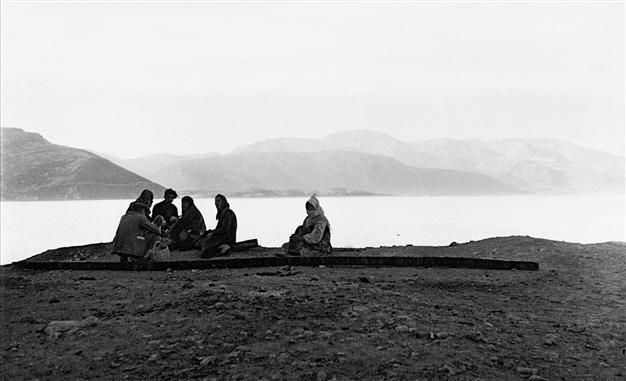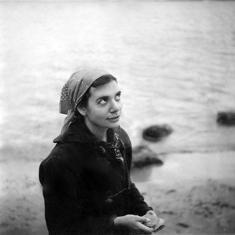Turkey’s first academically trained female photographer gets her dues
ISTANBUL

Moran was a photographer who put her soul, intellect, and heart into her work, thereby lending a great depth to her images and her overall work.
The Suna and İnan Kıraç Foundation of Pera Museum is honoring Yıldız Moran, a trailblazer for female photographers, with a new exhibition that started this month and will continue into the near year.
As the first female photographer in Turkey to hold a degree in her field, Moran constantly pushed her own standards and limits with new quests over the course of her 12-year-long career in photography.
Through her unique, lyrical language of photography and particularly her photographs focusing on Anatolia and its people, she soon became one of the stars of photography in Turkey.
Moran, who was born in 1932 and died in 1995, began her career in photography with great passion, only to give it up after marrying Özdemir Asaf, the other great passion in her life. Nevertheless, during her brief career, Moran was able to produce significant and diverse work after studying with the famous photographer John Vickers in Britain. Her first solo exhibition was in Cambridge at Trinity College in 1953 and was followed by others in Istanbul, Ankara, London and Edinburgh.

Besides her technical prowess and her masterful use of light, Moran was a
photographer who put her soul, intellect, and heart into her work,
thereby lending a great depth to her images and her overall work. This
comprehensive exhibition, a “retrospective,” aims to present Moran’s
inner voice through a new reading that focuses on the traces of her
visibility within the history of Turkish and international photography.
With
many photographs exhibited for the first time (along with a limited
number of others she became famous for), the exhibition offers a
wonderful opportunity to introduce a personality that, until now, has
remained in the dark. Moran was the first female photographer of
Turkey’s republican era to receive academic training in photography and
exhibit her works abroad. Using light with great mastery in the images
she produced, Moran stepped beyond “taking” photographs and recording
them technically and transmitting images onto photo-sensitive film – and
was able to pour her whole self into the images, deepening their
effect.
“The 12 years encompassing the period (1950-1962) Yıldız
Moran took photographs can be considered as one of the times in which
political history had a profound impact on the definition of
photography. In the early 1950s, the world was still dressing the wounds
of World War II. Following the emergence of genocide photographs from
Auschwitz and Buchenwald, as the United States, struggling with the Jim
Crow laws, maintained cultural diplomacy, its soul-searching led to the
exaltation of photojournalism and documentary photography, further
strengthening a conception of photography that, since the Industrial
Revolution, had been holding apparent ‘reality’ as its basis over the
seeing ‘eye.’ While abstraction took the seat of honor in the art of
painting, photography, in the general sense, was confined to the
immediacy of the notion of documentation as the evidence of what was
real and concrete,” academic Esra Özdoğan said about Moran.
 Turkey’s other photographers
Turkey’s other photographers“Following the transition to multiparty politics, photojournalism in Turkey ascended to a throne it would not relinquish for many years to come. Ara Güler and Fikret Otyam began working as photojournalists during the same years as well. Semiha Es was appointed to photograph the Korean War in the same period. As the straightforward documents of a culturally and intellectually developing Republic based on man and society, photographs came to fore with their simplicity and propinquity,” she said.
According to Özdoğan, Moran’s discourse on photography is just as striking as her photographs and fresh as though it were just articulated today. Moran’s unparalleled place in Turkish photography should not be explained by her gender, her certified education abroad, or her solitary travels across countries she photographed, but rather in terms of her deliberate choice to install the plain reality in her photographs behind her art in the golden age of documentary photographs and objective aesthetics.

 Besides her technical prowess and her masterful use of light, Moran was a
photographer who put her soul, intellect, and heart into her work,
thereby lending a great depth to her images and her overall work. This
comprehensive exhibition, a “retrospective,” aims to present Moran’s
inner voice through a new reading that focuses on the traces of her
visibility within the history of Turkish and international photography.
Besides her technical prowess and her masterful use of light, Moran was a
photographer who put her soul, intellect, and heart into her work,
thereby lending a great depth to her images and her overall work. This
comprehensive exhibition, a “retrospective,” aims to present Moran’s
inner voice through a new reading that focuses on the traces of her
visibility within the history of Turkish and international photography. Turkey’s other photographers
Turkey’s other photographers